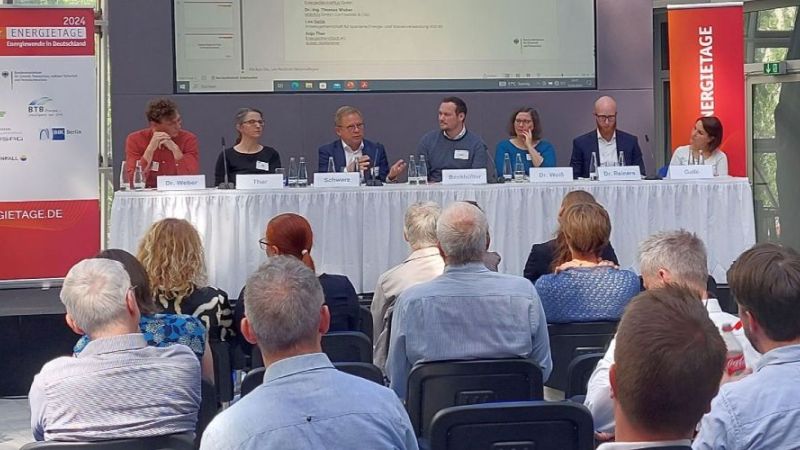 © centrotherm / Thomas Pernau
© centrotherm / Thomas Pernau
Photovoltaics
Regenerating solar cells by using hydrogen
Thomas Pernau Mission Electricity Transition 2045
INTERVIEW WITH DR THOMAS PERNAU
Hydrogen is not only discussed as an energy medium; it has many uses as a chemical element. Within the Upgrade Si-PV project, the project partners also investigated its function in the regeneration of solar cells. Current, highly efficient silicon solar cells can lose efficiency as soon as they are exposed to light – a preventable effect. The hydrogen-containing layers used for this purpose in the project were produced using PECVD, which is a method in which the individual constituents are introduced as a vapour and deposited from it. The work was coordinated by centrotherm, a producer of PECVD systems. Project manager Dr Thomas Pernau reports on the results in an interview.
What is this effect that occurs in the solar cells?
There is a special mechanism behind this. This is due to the boron-oxygen complexes that we investigated in the project and that are contained in every silicon solar cell doped with boron. These complexes are initially inactive and do not interfere with the free charge carriers. However, they can be activated relatively easily through light. If the light-generated charge carriers then encounter activated boron-oxygen complexes, there is a very high probability that the charge carriers will be intercepted. And that means poor efficiency for the solar cell. But we have seen that hydrogen can counteract this: If you introduce hydrogen and activate it, then it can intervene in these boron-oxygen complexes by electrically inactivating them. We summarise this under "regeneration of the solar cells", for which we have further developed the regeneration furnaces in our project.
How does the process work exactly?
This is a special form of hydrogen passivation. This means that the atomic hydrogen settles at a position of the boron-oxygen complex that was previously electrically active. And by being occupied by the hydrogen, these states are no longer active - the complex becomes inactive and can no longer cause any damage. We therefore introduce hydrogen into the cells in a regeneration furnace in order to inactivate these boron-oxygen complexes and other comparable complexes.
What other complexes are you referring to here?
There is also a general component to the whole issue of regeneration. There are a number of contamination complexes that are similar in terms of damage progression. One thing that is currently being discussed more is LeTID, the abbreviation for "Light and elevated Temperature Induced Degradation". This means that the solar cell loses efficiency as a result of light in combination with higher temperatures. And one wonders what exactly is the reason for that. The likely cause is metal complexes, possibly also with hydrogen participation, which in turn also become active through light plus activation energy. But these can also be passivated again with suitably activated hydrogen. Such project ideas that focus on LeTID are in principle also follow-up projects to Upgrade Si-PV, because they have similar defect genetics.
What do these approaches mean for the future of production technologies?
I hold out hope that working on and unravelling more light degeneration effects will also bring you back to the regenerator. Because in the course of the project I saw that even wafers that were light degraded at elevated temperature according to LeTID were regenerable again - at higher intensity. So I would say there is a larger defect class of processes driven by light and temperature that can all be dealt with by the regenerator. This might give the regenerator something of a revival, especially of course a powerful high-intensity device. We have laid the foundation for this with Upgrade Si-PV. At the end of the project, we developed an LED-illuminated generator part that achieves a very high intensity.
The regeneration furnace as such was also one of the main topics of the project.
At that time, we were the first to have large and efficient regeneration furnaces. The first furnaces still looked different. These furnaces were also initially only available for laboratories, not yet for industrial production. The wafers tended to be heated too much by the lighting, or the treatment time was too long for industrial use. We started in 2015, then on 1 January 2016 the project came with all the important findings. Based on this, we optimised the furnace regenerator at the University of Konstanz. This furnace has become 30 per cent smaller with the same or better performance. This head start in knowledge is how we built our business. Because at that time we were able to do something that no one else could. By now, everyone has the strong light exposure of the solar cells under control, which at the same time also generates heat. Consequently, there are foreign companies that produce such furnaces more cheaply. However, we are now pursuing concrete further developments in interesting follow-up projects such as Hydra, which will allow us to optimise the use of the furnaces. The second wave is coming, in the form of further optimised plants that make it possible to introduce and modify hydrogen in a targeted manner.










